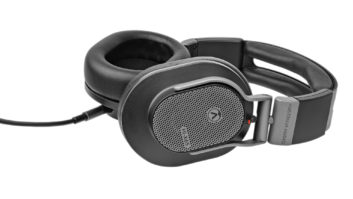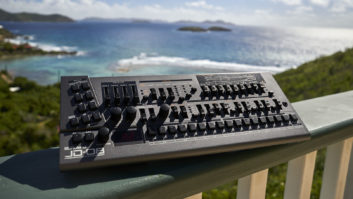
When you hear the name “Ocean Way,” you probably picture the iconic studios that bear, or once bore, the name, where countless hit records have been recorded. Allen Sides, the legendary engineer behind those studios, also makes high-end studio monitors through his Ocean Way Audio brand.
In commercial studios, you’re more likely to find the company’s three-way monitors with horns, often soffit-mounted in a control room. With large footprints and price tags north of $10,000, they’re not practical for all but the most elaborate personal studios.
But recently, Ocean Way Audio released the Pro3, which is the latest in its smaller (and less-expensive) OWA monitor line. The company refers to the Pro3 as its “most affordable” monitor pair yet. At $3,000 for a pair, some might quibble with the term “affordable,” but it is within the range of many studios and recording musicians; to many, its high-end, pro-level sound quality makes it an exceptional value.
NOT BAFFLING AT ALL
The Pro3 monitors are the smallest that Ocean Way makes. The cabinets are designed to reduce baffle reflections and low-frequency resonance. Each monitor features a circular port at the top of the back panel.
With dimensions of 9 x 14 x 13.5 (W x H x D) inches and weighing 23 pounds each, the Pro3 is small enough to fit in any-size room. They’re two-way active monitors with plenty of power—125W per side for the aluminum low-frequency driver and 90W for the silk fabric dome–type tweeter.
Compared to most studio monitors these days, you could call their control set “minimalist.” What there is resides on the back panel. The front of the Pro3 has only the woofer and tweeter. The power indicator light is on the rear, not the front. I’m not sure I understand that design choice; to me, it makes more sense if you can see it from the listening position.
BACK PANEL
The Pro3s offer two input options: Analog and Digital AES/EBU, both on XLR connectors. An AES/EBU digital XLR output is also included. The monitors can be switched between four different presets: Preset 1 is the default, with the analog inputs active. Preset 2 is also analog, for use with a subwoofer. When it’s on, a fourth-order highpass filter rolls off at 85 Hz so as not to get in the way of the low frequencies coming from the sub. The other two presets are for digital input. Preset 3 sets the monitor to digital left input and Preset 4 to digital right.
The process for changing presets is not what I’d describe as user-friendly. Each monitor features a small recessed button on the back panel called the LED Selector. Near it is a series of four LEDs: two white and two red. The manual recommends using a “small blunt tool,” or breaking off the end of a cotton swab to make adjustments. Pressing and holding the LED Selector for a second or more switches the white LED from 1 to 2, which toggles the active status of the analog and digital inputs.
Campfire Audio Satsuma – A Real-World Review
Quicker presses set the two red LEDs, which blink when you first adjust them. The combination of white and red LEDs that are lit determines which preset is active. Fortunately, you probably won’t have to adjust them very often, if at all. I never thought I’d find myself wishing for dip switches, but I did in this case.
Each speaker also features a Master Volume control for trimming the output. It’s recessed and requires a small screwdriver or a tweaker to adjust it. It’s not detented, but has 10 position indicators printed around the recessed area, making it pretty easy to set the left and right evenly if you need to lower the volume.
That’s it for the controls, save for the power switch and voltage selector. Ocean Way Audio includes IEC power cables for each monitor.
Somewhat surprisingly, there’s no room correction filtering or EQ that you can deploy on the Pro3s other than the high-pass filter for subwoofers that’s available with Preset 2.
TAKING THEM FOR A SPIN
I set up the Pro3s in a nearfield configuration, placed on speaker stands on top of Primacoustic Recoil Stabilizers, which are thick and heavy monitor pads. The Pro3s don’t have rubber feet, so you’ll want to use pads or decoupling stands. I connected the Pro3s to the outputs of my Cranborne Audio 500R8 interface, opened Ableton Live and hit Play on a song I’d been working on.
My first thought was, “These monitors are really bright.” But I soon realized that what I was reacting to was clarity. Everything in the mix sounded clearer and more present— the drum loops, the bass, the guitars and the keyboards. The transient reproduction was beyond impressive.
When I switched back and forth between the Pro3s and my regular monitors (I’m not naming names because it’s an unfair fight), which I like a lot, the contrast was enormous. Not only are the Pro3s excellent for mixing, their sonic clarity makes them extremely helpful in adjusting mic placement when setting up for a tracking session.
The bass response on the Pro3s is extremely tight and defined. The specs show that it goes down to 45 Hz. Mixing on the Pro3s, I found it easier to accurately gauge the level of the kick drum and bass than with my regular monitors. The imaging on the Pro3s is also impressive. According to the company, the frequency response between the two speakers is within ±0.5dB.
CRANK ‘EM UP
I was curious how the Pro3s sounded at higher levels than the 70 – 80 dB range I’d been listening in. I cranked the music up to over 90 dB—which, with the speakers less than three feet from my ears, was quite loud. I expected to hear the clarity diminish, but it didn’t. The monitors sounded louder but otherwise no different than at lower volumes.
If by chance you push the level up too high, the monitors are equipped with overload protection circuits that would prevent damage to the drivers and other components.
I mixed a couple of full songs on the Pro3s and got excellent results. I noticed less ear fatigue than I was used to on either pair of monitors that I use regularly in my studio. The ability to listen longer before you have to stop for a long break, or until the next day, could be a real boon for mixing productivity.
The last thing I tried was hooking up a subwoofer. I own a KRK 10s sub and connected its left and right outputs to the inputs of the Pro3s. After switching the monitors to Preset 2, to activate the high-pass filtering, I let it rip. With that extra bass, the overall sound of the system was magnificent.
Ocean Way Audio makes a couple of subs, the S10A and the S12A, which would probably sound better matched with the Pro3s than what I tried out here. But even with a sub from another manufacturer, the results were stunning.
QUALITY AND CONSISTENCY
Doing this review has been an eye-opening, or rather, an ear-opening experience for me. The Pro3s are hands-down the best-sounding monitors I’ve used in my studio. I’ve reviewed quite a few, but these stand above.
As noted, I have a few small issues. One is the lack of room correction features. Incredible as the Pro3s sound, if you have acoustical issues in your studio that you need to compensate for, they’ll be there no matter which monitors you use. I also wish they would add a front-panel power LED and that the switching system for the Presets was easier to use.
But when weighed against the stunning sound quality and performance of these monitors, those issues pale to insignificance. The headline here is that from a sonic standpoint, the Pro3s are a revelation and definitely worth every penny. If you’ve never considered spending three grand on a monitor system, you might want to change your mind.
PRODUCT SUMMARY
COMPANY: Ocean Way Audio
PRODUCT: Pro3 Monitors
WEBSITE: oceanwayaudio.com
PRICE: $3,000
PRO: Exceptional clarity and detail. Tight bass response. Impressive bass extension. Excellent imaging. Less fatiguing than many monitors. Analog and AES/EBU inputs. Subwoofer mode adds high-pass filtering.
CON: No room-correction features. No front-panel power-status indicator. Preset switching could be easier.







